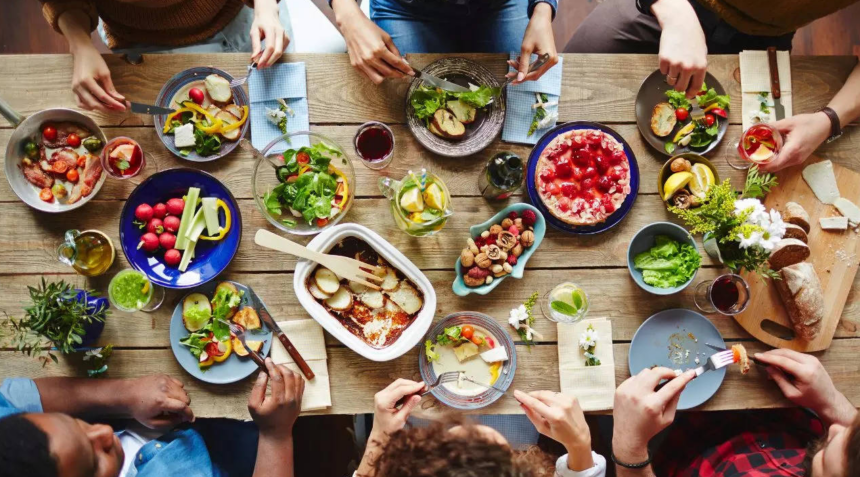Our food Practices and preferences are deeply rooted in our culture. People also connect to their culture or ethnic group through similar food patterns. Immigrants often use food as means of retaining their cultural identity for example Buddhist practice vegetarianism and fast on special days. Parsis are invariable meat eaters and have no food restrictions. Jews prefer to prepare in a style prescribed by their holy texts. To distinguish their diet from food eaten by other communities, jews label their food choices as ‘kosher’. The definition of kosher is usually explained as acceptable or proper.
Followers of the Hindu religion, which is primarily in India, Nepal and Srilanka, believe that the body is made up of natural elements. Earth, air, fire, water etc hence the dietary code is followed. However not all Hindus choose to practice vegetarianism, and they may adhere to the religions dietary codes in varying degrees of strictness. For examples, some Hindus refrain from eating beef and pork, which are strictly prohibited in the Hindu diet code, but do eat other meats.
Mongols like salty tea, as we love in Kashmir. It is usually served to guests when they arrive at a Mongolian home. Guest are served with fresh brewed tea and prepared in presence of the guests. Stale and warmed tea is a symbol of disrespect.
Dastarkhan
The traditional set table in central Asia, a part of central Asia traditional cuisine and the entire dining ritual. During the dastarkhan session green tea or black tea with milk should be served. Visitors to the region find the central Asian food very tasty-Tajikistan’s mastoba (mutton soup) is widely liked. The name mastoba is very close to our ‘Goshtaba’ though the latter is mutton beaten with fat cooked in curd and oil.
The harsh climate and desert land scape and nomadic lifestyle in Turkmenistan have influenced its cuisine. Plov, soups, and mutton are popular. The Uyghur now suppressed lot have been living Xinxiang for centuries and have experimented with many types of food production, and preparation. Nan (Bread), samsa (roasted stuffed Buns) are very popular within the Uyghur community. Manta filed with mutton chopped, boiled, added with herb’s is an ideal breakfast.
Halva (sweet porridge) made mainly with corn flour and cooked with chopped turnip, onion, and tomato is another preferred cuisine. Lamb intestine stuffed with rice, steam lamb lungs, ‘toksunsoman’ is another favourite dish. Animal products are used to make dishes such as roasted lamb, kebabs, but not the one we in Kashmir make. Meat balls unlike our ‘ristas’ are also on the favourite list of dishes. The most popular beverages are milk tea with salt, same as our ‘noonchay” home made popular yogurt is also very popular.
I would not resist licking my fingers after tasting a ‘Non-kabab’ made by few remaining yarkandis during my childhood, in downtown area of Saffakadal Srinagar. Nan kababs were made of sugar and flour. Yarkandis would also sell hot muntos royal in taste and rich in flavour. Many of Uyghur Community who were compelled to live in Srinagar, after partition moved to Turkey and other parts of central Asia, few remaining have amalgamated with Kashmir culture and forgotten their own tradition and customs.
Food Tourism
Food tourism refers to travel for the purpose of enjoying beautiful landscape and tasty food together. This form of tourism is currently popular and many tourist destinations around globe promote and organise food events. Countries like France, Italy Thailand not only offer to see the abundant sites of must see places but also because of the charm of the food at these destinations. Singapore ranked number one in the world’s best street food for 2019, and Bangkok and Hong Kong came in second and third.
During my visit to countries like, Nepal, Thailand, Singapore etc., I found thousands of people show up to eat dog and cat meat. I was told in Bang Kong that many pets are stolen, tortured, butchered, cooked and eaten however there are no dog farms they use stray and stolen pets.
During my stay in pataya, a beautiful tourist destination I was watching a lady from north-eastern part of Thailand standing by the pence at the crowded sea beach offering different fried creatures, water bugs, silk worms’ grasshoppers, cockroaches, and birds from a push cart. Fried frogs, snakes and beetles were also being sold at different tourist spots. My wife felt nauseating and started vomiting on seeing such creatures being eaten. Both of us turned vegetarian in many Fareast countries.
In Kulampur Malaysia, we were tempted to have duck soup with salted vegetables, a well – loved Chinese homestyle soup that originated from the Fujian province in china. Chinese settlers have greatly influenced and contributed within the Malaysian food culture. Fish curry and fried wheat noodles are also liked in far-east and in Southeast Asia.
Late Prof. Shams-ud-Din Ahmad former Head of the Department of Persian Kashmir University in one of his lectures I remember said, food is a language that brings us all together. He further said for Iranians the food is not just a meal but rather a culture in which they use food to express their identity etc. Rice preparation is indeed a food art in Iran. There are endless verities of dishes that can be prepared with rice here. Iranians also make breads such as Lavas, as we prepare here in Kashmir. Some Kashmiris were also taught to cook by Persian chefs. Our people mastered cooking cuisines like, Tabak- Maz, Aab-Gosh, Rogan – Josh etc. He added.
Whatever its connection with ‘central Asia, wazwan ‘is the central icon’ of our cuisine, not only is it tummy filler but its preparation is now considered an art and regarded as the pride of our culture and identity. Over the time it is has developed gradually. From just seven dishes it has grown to 36 mouth-watering dishes. Cooks from Wazpora and Naidkadal Srinagar fuse their cooking styles with Persian and herbal flavours.
Over the past decades, we are seeing that diets around the world are changing and they are becoming more similar usually termed as globalised diet. Urbanization has separated a large part of the world’s population from the direct production of foods, which has produced changes in eating behaviour.
As convenience takes everything else, the cuisine of the smaller, less mainstream communities is certainly put at risk opines many chefs. In short we need to bring the importance of community back into food. The connections that food own creates between people are valuable to overlook.
(Author can be reached at: [email protected])








